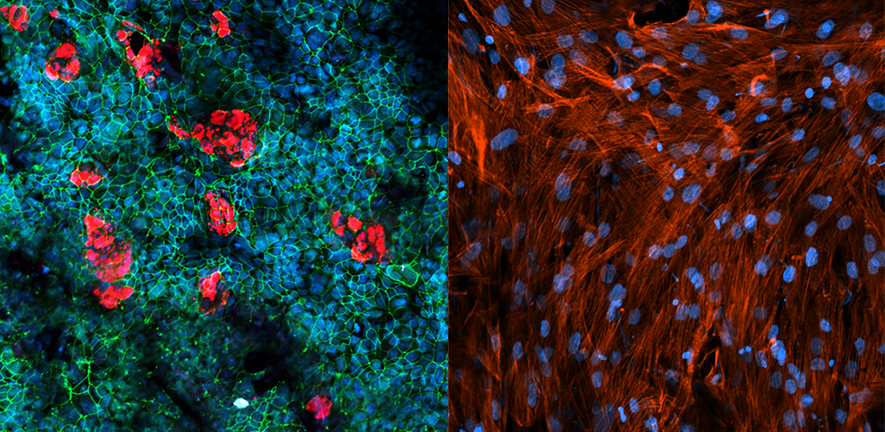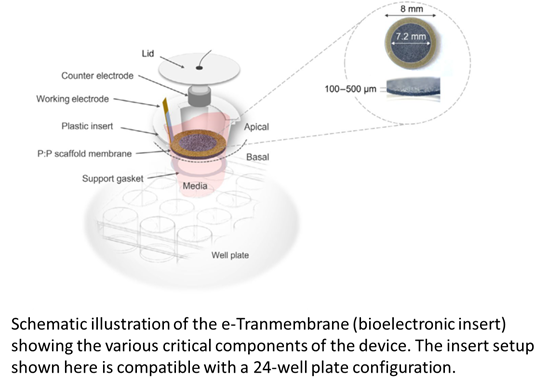
Submitted by Ellie Hall on Fri, 23/09/2022 - 12:42
Researchers in our Bioelectronic Systems Technology Group have developed a bioelectronic platform to grow and monitor 3D cell cultures in real-time, that can be used to deliver more predictive, high throughput drug screening assays.
Their ‘e-transmembrane’ platform can be used to grow different cultures of human cells in three-dimensions, more accurately modelling human tissues and organs. The multi-well plate configuration of their system, and the real-time measurements its electronic properties enables, could be used to provide more accurate and relevant data in drug discovery research.
A key stage in developing new treatments for diseases is testing the efficacy and toxicity of potential drugs on different cell types. Traditionally, this has involved testing potential drug candidates on flat, two-dimensional monolayers of specific human cells, before moving to more involved animal testing.
However, two-dimensional cell models don’t accurately reflect the complex 3D environment in which such cells exist within the human body. The inadequacy of these 2D cell cultures to provide the required data, has been a major contributing factor in the high failure rates of drug discovery research.
Animal studies, while currently the ‘gold standard’ for preclinical drug trials, also pose limitations. There are obviously physiological differences between different species and humans, and animal testing is expensive, time-consuming and ethically challenging.
Focus has therefore shifted to developing structures that can support the growth of cell cultures in 3D, which can better mimic the environment within the human body.
In a paper published in Science Advances, a team of researchers led by Professor Róisín Owens at the Department of Chemical Engineering and Biotechnology, describe how they’ve developed a device that combines several key properties essential for effective drug screening.
“We previously made devices for studying human health,” explains Owens, “but we were aware of a need to make platforms useful for scientists who need robust data for medium to high throughput drug screening. Our e-transmembrane platform provides an important step towards this goal.”
Using a special conductive polymer, called PEDOT:PSS, they constructed porous scaffold membranes, within which they could grow different cultures of cell types. With this flexible scaffold as a support, and by using human tissue-specific cells in combination, they were able to build up 3D models of both the intestinal epithelium and the vascular endothelium – tissues layers that play a key role in absorbing and distributing drug treatments in our bodies.
Furthermore, because the polymer support is conductive, the researchers are able to monitor what’s happening to the cells in these models in real-time. Cells generate small electrical signals, which provide information on their structure, state and how they’re interacting with other cells, molecules or components in their environment. By monitoring these electrical signals, the researchers can see how the cells are growing and developing into their 3D tissue networks and what effect potential drug candidates have on this.
Combining these so-called ‘e-transmembranes’ with multi-well plates that are used in drug discovery to take lots of tests at once, enables researchers to run high-throughput studies on cell models that more closely resemble their natural in vivo environment.
“We showed that the platform could be used for studying models of the gastrointestinal tract and vasculature giving highly quantitative information on tissue integrity,” says Owens.
The researchers believe their platform has the potential to become a universal tool for biologists and future work will look at expanding the repertoire of tissues to lung, blood brain barrier, oesophagus and vaginal epithelia for a host of drug discovery and disease modelling applications.
“We’ve patented this technology and are working with local biotechnology company, CN Bio Innovation, to continue development,” says Owens. “We’re working on adding additional features to make this an essential tool for early stage drug discovery.”


